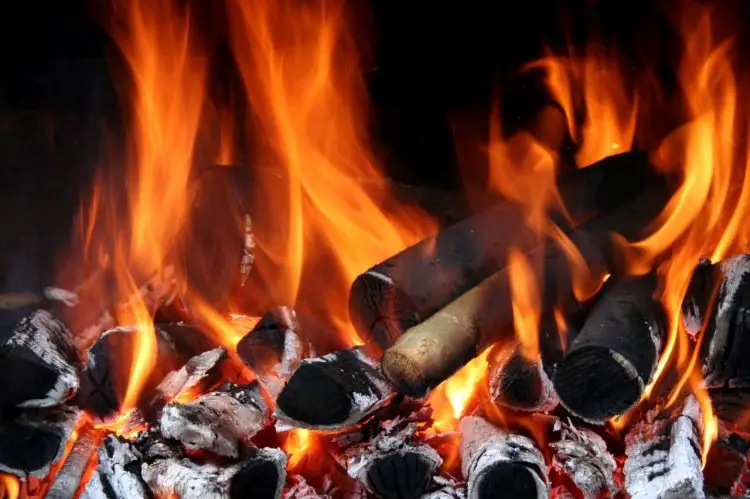How Hot Does Wood Burn? All You Need To Know!
Many private houses are equipped with a fireplace. But it is not enough just to put any wood in it and wait for maximum heat. To heat your home properly, you must have complete information about how hot does wood burns, as well as the best wood that will be used.
For medium-density wood at equilibrium humidity with the surrounding air, the wood ignites at about 300°C (572°F) and burns at a temperature ranging from 800 to 950°C (1472 to 1742°F). Softwoods like pine ignite around 300°C (572°F); hardwoods like oak need 400°C (752°F).
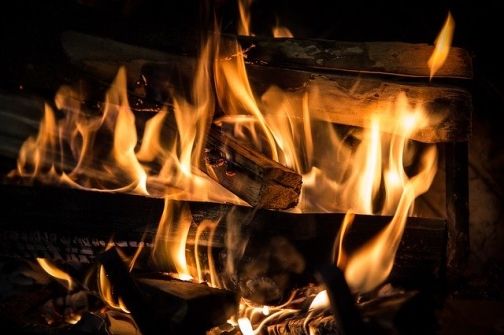
Hard, dense woods burn hottest. For example, dry oak sustains temperatures over 900°C. The fire starts at the exterior of the wood before propagating inward as gases are released through pyrolysis. Controlling airflow and using properly seasoned wood helps achieve ideal burning temperatures for applications like heating, cooking, or industrial processes
Combustion begins on the exterior as the wood releases flammable gases and heats up. Internal temperatures reach 600-950°C before gases are fully expelled. Controlling air flow and using dry, seasoned firewood below 20% moisture allows fires to burn hotter and more efficiently for heating or industrial processes.
The temperature during burning ranges from 840 to 900 degrees. When it is necessary to make an open fire or to light the logs in the barbecue, it is advisable to use pine. It is also often used to heat a home by placing it on a stove.
Wood burning temperature threshold of different types of wood
Depending on the structure and density of the wood, as well as the quantity and characteristics of the resins, they depend on the firing temperature of the wood, on the calorific value, and the properties of the flame.
| Wood Type | Burning Temperature (°C) | Burning Temperature (°F) |
|---|---|---|
| Western Red Cedar | 354 °C | 669.2 °F |
| Redwood | 364 °C | 687.2 °F |
| Radiata Pine | 349 °C | 660.2 °F |
| Douglas Fir | 350 °C | 662 °F |
| Oak | 900 °C | 1652 °F |
| Victorian Ash | 311 °C | 591.8 °F |
| Birch | 816 °C | 1500.8 °F |
| Spruce | 620 °C | 1148 °F |
| Beech | 950 °C | 1742 °F |
| Maple | 815 °C | 1499 °F |
| Hickory | 890 °C | 1634 °F |
| Ash | 850 °C | 1562 °F |
| Black Locust | 900 °C | 1652 °F |
| Apple | 832 °C | 1530 °F |
| Cherry | 815 °C | 1499 °F |
| Elm | 815 °C | 1499 °F |
| Walnut | 815 °C | 1499 °F |
| Alder | 730 °C | 1346 °F |
| Hornbeam | 900 °C | 1652 °F |
| Pine (Yellow) | 860 °C | 1580 °F |
If the tree is porous, then it burns very intense, but will not give high burning temperatures – the maximum value is 500 degrees °C.
But denser wood, such as hornbeam wood, ash, or beech wood, burns at a temperature of about 1000 degrees °C. Just below the firing temperature near birch (about 800 ℃), as well as oak and larch (900 °C). If it comes to such woods as spruce and pine, they light up at about 620-630 degrees °C.
Burning wood for heat or cooking is actually a combustion, given that it is total.
| Wood-Burning Activity | Optimal Temperature Range [Degrees Celsius/Degrees Fahrenheit] |
|---|---|
| Cooking (Grilling) | 175 – 260 °C / 347 – 500 °F |
| Cooking (Smoking) | 107 – 121 °C / 225 – 250 °F |
| Wood-Fired Ovens | 370 – 540 °C / 700 – 1000 °F |
| Pyrography (Crafts) | 300 – 650 °C / 572 – 1202 °F |
| Fireplace (Heating) | 200 – 300 °C / 392 – 572 °F |
| Kiln (Ceramics) | 900 – 1300 °C / 1652 – 2372 °F |
As a result of the total combustion, at maximum yield, water, carbon dioxide and ash result. Ash represents between 0.5 and 1% of the volume of dry wood.
If the firewood is too wet and too thick or the air is insufficient (the draft is not good, the wood has been arranged so as not to allow airflow), the burning is incomplete, and dangerous gases (carbon monoxide, nitrogen monoxide) result and smoke.
The smoke is carbon (charcoal) driven by air or water vapor before it is completely burned and converted to carbon dioxide.
At what temperature does the wood ignite?
Specifically, wood reaches its autoignition temperature and begins burning around:
- 300-350°C (572–662°F) for piloted ignition, when an external flame or heat source is directly applied to the wood. This lower temperature range is common for starting controlled wood fires.
- 400-500°C (752–932°F) for spontaneous ignition, when no external heat source is present. This higher temperature range is the point at which wood can spontaneously combust from heat buildup alone.
The exact ignition temperature depends on various factors like wood species, moisture content, and oxygen availability. But in general, applied flames or heat reaching 300-400°C will provide enough energy to start the decomposition reactions and release of flammable gases that lead to sustained burning.
Pyrolysis – the process of decomposition of wood at high CO2 temperatures and combustion residues – takes place in three phases.
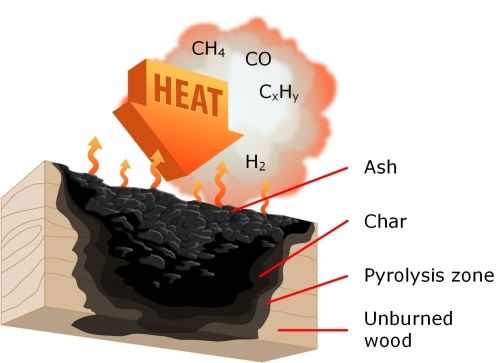
The initial process of wood burning is at 160-260 degrees Celsius (320 degrees Fahrenheit). Irreversible changes begin to appear in the wood, ending with fire. The ignition temperature of the wood varies between 200-250 degrees Celsius (392-482 degrees Fahrenheit).
The second phase of wood burning is 270-430 degrees Celsius. Start the wood decomposition under the action of high temperature.
The third phase is characteristic of a campfire or a burning furnace. The firing temperature of the wood in the third phase is 440-610 degrees Celsius.
Under these conditions, the wood will ignite in almost any state and leave behind coal.
The different stages of the burning process
This is a complex burning process that is carried out in several stages:
- Evaporation Stage (100-200°C)
As the wood is initially heated, any moisture present in the wood starts being evaporated. Up to around 100°C, moisture is evaporated from the surface.
From 100-200°C, moisture trapped within the wood cells and structure starts to vaporize and escape. This stops once the internal moisture is depleted.
- Pyrolysis Stage (200-300°C)
At 150-300°C, the wood polymers (cellulose, hemicellulose, lignin) start decomposing through pyrolytic reactions.
This releases flammable gases containing combustible compounds like hydrogen, methane, carbon monoxide, and other hydrocarbons.
The gases escape and mix with air above the wood. The rate of pyrolysis increases rapidly with temperature.
- Gaseous Combustion Stage (300-500°C)
At around 300°C, the pyrolysis gases reach ignition temperature and start burning with a flame above the wood.
This exothermic reaction gives off heat that accelerates the wood pyrolysis process. More gases are produced and burned.
Temperatures of 300-500°C are typical for the flaming combustion of the gases above the wood fuel source.
- Char Combustion Stage (500-800°C)
Around 500°C, the wood structure starts turning to char as pyrolysis continues. The char starts oxidizing.
From 500-800°C, char combustion is the main heat release process, as carbon in the char reacts with oxygen.
The char surface glows and burns, releasing CO2 and CO. This stage provides the highest heat output.
- Burnout Stage (800-1000°C)
At 800-1000°C, char combustion continues until most of the carbon is consumed, leaving only ash.
Temperatures peak as the last char is burned. Proper airflow is key to minimize unburnt char.
- Ash Stage (above 1000°C)
After full burnout, only non-combustible ash and embers remain at very high temperatures above 1000°C.
The ash continues emitting heat until the fire is extinguished or new fuel is added.
Key Signs For a Correct Burn:
- Clean, Blue Flames:
- A correct burn is characterized by clean, blue flames. Blue flames indicate complete combustion of the wood, resulting in efficient and controlled heat output.
- Steady Heat Output:
- The heat produced during a correct burn is steady and consistent. There should not be extreme fluctuations or sudden increases in temperature.
- Minimal Smoke Emission:
- Proper combustion results in minimal smoke emission. Excessive smoke can indicate incomplete combustion, inefficient burning, or the use of wet or unseasoned wood.
- Ash Color and Texture:
- After the burn, the ashes should be light in color, typically white or gray. The texture should be fine and powdery. Dark or clumpy ashes may suggest incomplete combustion.
- No Unpleasant Odors:
- A correct burn should not produce strong, unpleasant odors. Foul smells may indicate the release of harmful substances or the burning of treated or painted wood.
- No Residue on Glass:
- If you’re using a wood-burning stove or fireplace with glass doors, a correct burn will result in minimal residue on the glass. Excessive creosote buildup suggests incomplete combustion.
- Efficient Fuel Consumption:
- During a correct burn, the wood is consumed efficiently, leaving behind minimal unburned residues. This ensures that you get the most heat energy from the wood.
- Consistent Flame Size:
- The flame size should be consistent throughout the burning process. Sudden changes in flame size or flickering can indicate issues with combustion efficiency.
The combustion must occur in the presence of flames, until the wood turns into charcoal. The purpose is a fiery, smoke-free burning.
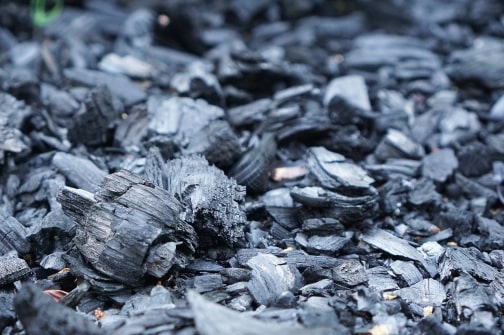
Chimney bricks in the combustion chamber (if any) should be colored yellow-brown, not black. Dry wood should light up immediately if sufficient air is available.
How does wood burn?
The isothermal reaction, in which a certain amount of thermal energy is released is called combustion. This reaction occurs in several successive stages. In the first stage, the wood is heated by an external source of fire to the point of ignition.
As the temperature reaches 120-150 degrees ℃, the wood turns into coals capable of self-ignition. When the wood temperature reaches 250-350 degrees ° C, combustible gases begin to release – this process is called pyrolysis.
At the same time, the burning of the top layer of wood, which is accompanied by white or brown smoke, is mixed with pyrolysis gases with water vapor.
In the second stage, as a result of how hot wood burn, the pyrolysis gases light up with a light yellow flame. It gradually spreads over the entire surface of the wood, continuing to heat the wood.
The next stage is characterized by inflammation of the wood. As a rule, for this purpose, it should be heated to 450-620 ℃.
In order for the firewood to ignite, an external source of heat is required, which will be sufficiently intense to strongly heat the wood and accelerate the reaction.
Factors affecting how hot does wood burn
Several factors contribute to how hot can wood burn:
- The grade of wood used for burning.
- Material moisture.
- The volume of air entering the furnace.
These are the main indicators that require special attention, because they depend on the efficiency of the wood burning and the temperature that can increase during the combustion process.
- Air
The wood burns in the best way and the flames are intense if the air inlet of the furnace is open. This will also reduce pollution, because the gas particles are burned and produce heat.
- Humidity level
The moisture content of wood plays a key role in firing, so this important point requires a separate analysis. Every tree that has just been cut has a certain moisture content. In most cases, this figure is 50%.
But in some cases, it increases to 65%. And this suggests that such material will be dry for a long time under the influence of high temperature before it ignites.
Some of the heat will work just to remove excess moisture through evaporation.
For this reason, the temperature will not reach the maximum value. The heat transfer under such conditions will decrease.
For maximum benefits, several basic options should be used:
- The best option is drying wood. To do this, the tree is cut into small pieces, then bent into a dry place in a warehouse or canopy.
- The second option is less preferable – to burn what is, without paying attention to humidity. But in this situation, you have to spend twice as much wood to form the desired temperature. In addition, you should be ready to clean the chimney.
Under natural conditions, the drying process will take approximately 1 year. And if the wood is stored longer and spread over two summers, then the humidity will be 20%. This is the optimal indicator.
Wood Type and Caloric Power of Wood
When choosing the right wood, you should know some shades. For example, if you use ash or beech, you can raise the temperature to a high level, but if you use it for a sauna or oven, it is very expensive and unprofitable – the wood burns fast.
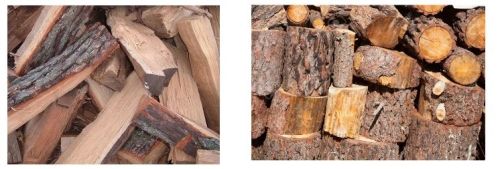
For this reason, people have started to use other types of birch. The birch firewood has a burning temperature of 800 degrees Celsius (1472 degrees Fahrenheit).
In the table below, we have a series of wood species that have the same humidity of 12%. This moisture is the default moisture of the wood left outside to dry.
Without artificial forced drying, the wood never reaches 0% humidity. I want you to understand that it is not necessarily a good thing to remove all the water. For burning at a normal stove the wood must be as dry as possible because there is only combustion.
| Wood Type | Caloric Power (kcal/kg) |
|---|---|
| Fir Wood | 3710 |
| Spruce Wood | 3700 |
| Birch Wood | 3610 |
| Maple Tree | 3610 |
| Acacia Wood | 3600 |
| Beech Wood | 3600 |
| Apple Wood | 3590 |
| Cherry Wood | 3560 |
| Oak Wood | 3460 |
| Pine Wood | 4300 |
| Ash Wood | 4000 |
| Walnut Wood | 3890 |
| Hickory Wood | 3900 |
| Cedar Wood | 3700 |
| Elm Wood | 3650 |
| Alder Wood | 3570 |
| Poplar Wood | 3450 |
| Willow Wood | 3400 |
Hardwoods emit more heat than softwoods with the same volume, but per kilogram, different types of wood will give the same heat.
Softwoods are cheaper than hardwoods and we recommend using them at the beginning and end of winter, when it is less cold. They offer a clean burning, without turning the house into a sauna.
They will burn faster but the fire can be extended by supplementing with hardwood.
If you are interested in seeing how hot each wood burns or the heat value of each type of wood, check this Combustion of Wood – Heat Values
Why not use wet wood? Wood moisture decreases caloric power. Most of the calorific power is used for the evaporation of water, the rest being insufficient to ensure the heating.
Water vapor lowers the temperature of the combustion and contributes to the formation of soot, which accumulates and hardens in a thick layer on the walls of the combustion chamber, ceramics, pipes, chimneys, etc.
Atmospheric pollution increases due to the fact that the gases leave the combustion chamber unburned.
Quality of firewood and the way of choosing firewood
Birch firewood has a better ratio of thermal efficiency and cost – it is not economically profitable to heat more expensive breeds with high temperatures of combustion temperatures.
Spruce, fir, and pine are suitable for fires – these conifers provide relatively moderate heat. But in a solid fuel boiler, stove or fireplace, firewood is not recommended for use – it does not emit enough heat to efficiently heat the home and cook food, burn to form large quantities of soot.
Low-quality firewood is considered to be fuel from aspen, linden, poplar, willow and alder – porous wood emits little heat when burned.
Alder and other types of wood “fire” with coal in the burning process, which can lead to a fire, if the wood is used to burn an open fireplace.
When choosing, you should also pay attention to the moisture content of the wood – raw wood burns worse and leaves more ash.
Conclusion
As you noticed different wood species have different ignition temperatures. In this article, we’ve shown how hot wood burns, having ignite ranges from 200 to 300 Celsius degrees (392 to 572 Fahrenheit degrees) and burning ranges from 840 to 950 Celsius degrees (1544 to 1742 Fahrenheit degrees).
The higher the burning temperature (800-1000 ° Celsius), the more complete the disintegration of the wood, the amount of energy released is higher, the efficiency of the installation is higher and the degree of pollution is lower.
Based on the wood burning ranges we can understand the various factors that affect the wood burning process. These factors will help you decide how you can make a great fire and what type of wood you need to choose based on your needs.
RECOMMENDED READING:

